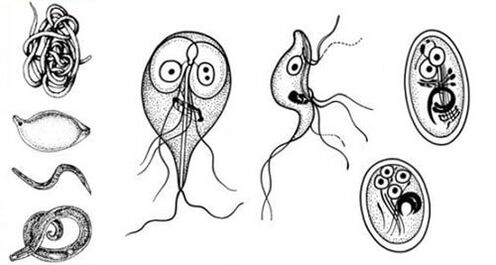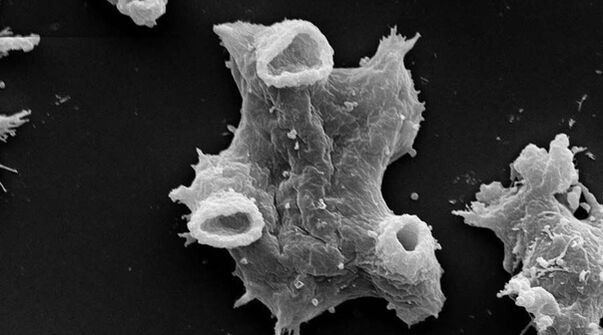Parasitic protozoan microorganisms are commonly referred to as parasitic protozoan microorganisms, ie, those parasites that are constantly present in the human body and feed on its "sap". They are not related to worms, but some single-celled parasites can reach great sizes.

They are completely separate creatures, although they have lost the digestive vacuoles caused by their lifestyle.
parasites
Representatives of various organisms can be divided into the following categories:
- sal code- negleria and amoeba.
- spore- Toxoplasma gondii.
- Ciliates‒ balantium
- flagellum- Leishmania, Trichomonas, Trypanosoma and Giardia.
These creatures were among the first simple creatures to appear on Earth. Their basic structure and working function lead to the development of deadly diseases. This list contains common representatives of protozoan parasites, but there are many more.
Effects on the body
Although these parasites are called protozoa, they have very negative effects on the human body and can cause serious diseases.
sal code
dysentery amoeba (Insectatissue).This parasite is most common in hot countries. A feature is the absence of bone and shell formation. She has athletic legs. It can form cysts in the body.
Amoebiasis is usually caused when the lining of the bowel is affected. A person has loose stools with blood. Diagnosing this amoeba is quite difficult. She is a very dangerous parasite.
Neglia Fowler.Humans are intermediate hosts. The location of the parasite is usually the brain.
Causes amebic meningoencephalitis, which is usually fatal.
flagellum
Trichomonas (Trichomonasvaginitis).The disease occurs in men who have almost no symptoms, but only in the carrier form. In women, it manifests as clear signs of inflammation: heavy discharge with an unpleasant odor, itching and pain in the lower abdomen.
This simplest of the parasites is usually sexually transmitted, but it happens that it is also spread through household contact. Infected women can infect their babies during childbirth.
Giardia.These microorganisms live in the gastrointestinal tract. Effects on the body include years of cystic carry, but the disease develops in a milder form. Rarely becomes chronic. By the way, they are not afraid of toxic substances and UV radiation.
spore
Leishmania (lesaniakind).This species is present in almost all human organs and eventually destroys them. Causes a serious disease - visceral leishmaniasis. In their habitat, a huge canker forms and decays constantly. It is difficult to treat and often requires surgery.
Plasmodium.It is located in plasma, red blood cells and liver cells. Worst of all, these simple creatures destroy red blood cells. Causes tropical and multiday malaria. Can severely damage the kidneys and destroy the nervous system.
Toxoplasma.It affects the lymph nodes and small intestine. Toxoplasmosis often develops, which can be very dangerous for pregnant women. In the initial stages of infection, it mimics a viral infection.
Ciliates
enteritis(ScarabsEscherichia coli).Usually affects the large intestine, especially the cecum. This is a fairly large single-celled organism that can easily be introduced into the bloodstream.
They don't do much harm to the body, but ulcers can develop in the gut.
Symptoms and diseases caused by protozoan parasites
Currently, a variety of pathogens have been found to cause the following diseases:
- Giardiasis.
- malaria.
- Leishmaniasis.
- Trichomoniasis.
- Cryptosporidiosis.
- Balanitis.
dysentery amoeba
Infection occurs through food and household items.
Symptoms in mild cases:
- flatulence.
- Abdominal cramps.
- Constipation is replaced by diarrhea.
Average severity of disease course:
- Symptoms increase within 10 days.
- There is weakness and loss of appetite.
- Bloody mucus stools.
- Feces are abundant.
When the disease becomes chronic, weight drops dramatically.
Pathology caused by this parasite:
- peritonitis.
- Amoebic appendicitis.
- dysentery.
- Lung and liver abscesses.
- Extremely rare amebic hepatitis and brain abscess.
- Cutaneous amebiasis with the development of ulcers and erosions.
As the disease progresses rapidly, even debilitated people can experience fatal results.
Naegleria fowleri

You can get infected with this parasite while swimming in ponds and in the air.
The disease always begins with the manifestation of acute symptoms:
- Loss of smell and taste.
- Headache and weakness.
- Nausea and the urge to vomit.
- Loss of movement coordination.
- Pulmonary edema may occur.
- Hallucinations and convulsions.
Diagnosing the disease is very difficult, so it usually ends in the death of the patient.
Negleria causes the following conditions:
- Amoebic meningoencephalitis.
- Nigeliasis.
- Destroy the brain.
- A person often falls into a coma.
Infections are usually fatal.
Lambia
The disease occurs without obvious symptoms. The infection is spread through unwashed fruit and dirty hands.
Typical symptoms:
- Increased salivation.
- Abdominal discomfort.
- Loss of appetite and nausea.
Sometimes green stools, foamy, and pungent odor.
Diseases caused by: Giardiasis and various intestinal dysfunctions.
Leishmania
The infection is caused by mosquitoes.
It exhibits severe symptoms:
- Spleen and liver enlargement.
- High temperature rises.
- Fever condition.
- Weak and pale skin.
- Bleeding of the skin.
- Heart activity problems.
- Anemia and severe weight loss.
Sometimes edema and pneumonia combine.
This parasite can cause cachexia, decreased muscle tone, impotence and heart failure.
Trichomonas
Infections occur with promiscuity and hygiene products. Symptoms are mostly absent but occasionally present.
For men:
Discomfort when urinating.
- There is blood in the semen.
- White discharge.
In women:Inflammation of the cervix and vagina.
Infection is very dangerous for pregnant women as it can lead to premature labor.
Plasmodium
Mosquito bites can lead to infection.
Plasmodium vivax. Symptoms depend on the stage of the disease:
- Chills up to 3 hours - muscle and joint pain, liver pain.
- Fever for about 12 hours - body temperature up to 40 degrees, drop in pressure, shortness of breath and tachycardia.
- Profuse sweating phase - The temperature drops sharply with muscle weakness and hypotension as sweat is released.
May develop into three days of malaria and may recover spontaneously. Splenomegaly, anemia, and sometimes jaundice may occur.
Plasmodium malaria.Fever occurs in the morning and evening. In addition, there were three days of signs of malaria. May lead to the development of difficult-to-treat nephrotic syndrome.
Plasmodium ovale.Fever only appears at night. The disease is easy to develop, but the liver may enlarge slightly.
Toxoplasma gondii
The routes of infection are quite extensive. You can get infections from undercooked meat, dirty products, blood transfusions, and cuts to the skin. By the way, infections in pregnant women are usually passed on to the fetus.
In the presence of acute illness, the following symptoms appear:
- The liver and spleen were significantly enlarged.
- signs of jaundice.
- rash.
- Typical symptoms of meningitis and encephalitis.
- Swollen lymph nodes.
Chronic form:
- High temperature for a long time.
- Muscle and bone pain.
- In women, the menstrual cycle is disrupted.
- Have headaches and irritability.
Also, thyroid and adrenal insufficiency may be a problem.
Infection with such parasites threatens the development of many diseases:
- Hypoactivity disorder.
- Toxoplasmosis.
- Seizures.
- Retinal inflammation.
- Enterohepatic syndrome.
Rarely, but still, lymph node sclerosis occurs.
small intestine
You can get parasites through raw water, dirty hands, and fruit.
Signs of infection:
- Prolonged diarrhea with pus and blood.
- Abdominal pain syndrome.
Balantidia leads to the development of peritonitis, organ abscesses, and perforation of the intestinal wall.
in conclusion
Protozoan infection is very similar to viral infection. They are not considered worms by definition, although they are extremely harmful to human health.
Infection with protozoan parasites can lead to death, so medical help should be sought immediately when typical symptoms appear. Self-medication is strictly prohibited.






































